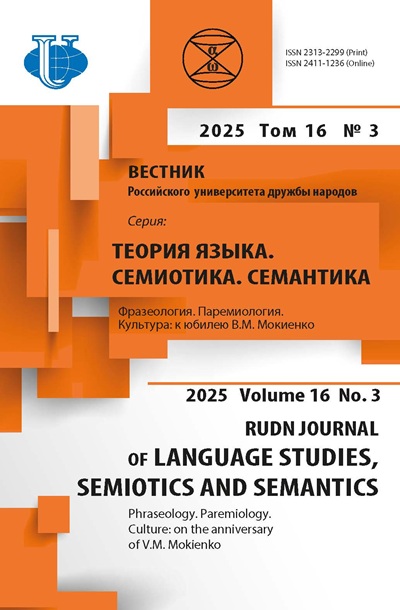SIMULACRUM IN STATIC-DYNAMIC SCOPE OF THE SCREEN (a case study of polycode-multimodal texts of the Internet)
- Authors: Evgrafova Y.A1, Maksimenko O.I1
-
Affiliations:
- Moscow regional state university
- Issue: Vol 9, No 4 (2018)
- Pages: 831-841
- Section: LANGUAGE THEORY
- URL: https://journals.rudn.ru/semiotics-semantics/article/view/20141
- DOI: https://doi.org/10.22363/2313-2299-2018-9-4-831-841
- ID: 20141
Cite item
Full Text
Abstract
With onset of the computer and electronic revolution, with the expansion of the Internet the modern world culture is based not on the bookish, but on the screen form of the text existence. Heterogeneous texts have replace homogeneous texts. The most formed representatives of which are the movies and the television, that initiated the appearance of text with the unique structure, contaminating oral and written linguistic sense medium with the non-linguistic and which, having been digitized, are predominating in the Internet today. The spectator expects from these texts such stylistic features as authenticity and factual accuracy. These particular expectations are employed by the authors of such videos in order to manipulate the viewer and to create the impression, that the objects and phenomena on the screen possess the denotation in the real world, thus making the recipient believe into the modelled pattern of a real life and generating simulacra. This article is devoted to the analysis of peculiarities of the simulacra design in polycode-multimodal texts representing complex semiotic unity of verbal, iconic and acoustic components. Also it is examined how a real-life simulation is created in the case of three polycode-multimodal texts that describe the military actions in Syria. The analysis is carried out in the static and dynamic scope of the screen% at the visual (screenshots), verbal and acoustic levels. During the research lingual-semiotic peculiarities of the simulacra generation in the static scope of the screen are singled out and the instruments used to construct simulacra in the dynamic scope of the screen.
Keywords
About the authors
Yulia A Evgrafova
Moscow regional state university
Author for correspondence.
Email: 212.155.04@mail.ru
Ph.D. in Philology, Associate Professor, Associate Professor, Department of Indo-European and Oriental Languages, Faculty of Linguistics, Institute of Linguistics and Intercultural Communication, Moscow State Regional University
10A, Radio st., Moscow, 105005, Russian FederationOlga I Maksimenko
Moscow regional state university
Email: maxbel7@yandex.ru
Doctor of Philology, Professor, Professor, Department of Theoretical and Applied Linguistics, Faculty of Linguistics, Institute of Linguistics and Intercultural Communication, Moscow State Regional University
10A, Radio st., Moscow, 105005, Russian FederationReferences
- McLuhan, G.M. (2003). Understanding Media: External Human Extensions Moscow: Zhukovsky: CANON-press C., Kuchkovopol. (In Russ.).
- Eco, U. (1998). From the Internet to Gutenberg: text and hypertext: excerpts from a public lecture by Umberto Eco at the economic faculty of Moscow State University on May 20, 1998. URL: http://vzms.org/umberto.html (accessed: 08/10/2018). (In Russ.).
- Sorokin, Yu.A. & Tarasov, E.F. (1990). Creolized texts and their communicative function In Speech Optimization. Moscow: Nauka. pp. 180-186. (In Russ.).
- Anisimova, E.E. (2003). Text linguistics and intercultural communication: on the basis of creolized texts. Moscow: Academia. (In Russ.).
- Bernatskaya, A.A. (2000). To the problem of “creolization” of the text: history and current state, Speech communication: Specialized Herald. Krasnoyarsk: Krasnoyarsk. state Univ., 3(11). (In Russ.).
- Bolshakova, L.S. (2008). On the content of the concept of “polycode text”, Bulletin of Novgorod State University, 49, 48-51. (In Russ.).
- Sonin, A.G. (2006). Modeling mechanisms for understanding polycode texts: [dissertation]. Moscow. (In Russ.).
- Maksimenko, O.I. (2012). Polycode vs. Creolized text: problem of terminology. Bulletin of Peoples’ Friendship University of Russia. Series: Theory of language. Semiotics. Semantics, 2, 93-102. (In Russ.).
- Kobzeva, E.V. (2017). Polycode text as an object of philological analysis, News of the Volgograd State Pedagogical University, 10(123), 58-62. (In Russ.).
- Kostomarov, V.G. (2011). Screen Texts and Dialogue of Cultures In Dialogue of Cultures in the Context of Globalization: XI International Likhachev Scientific Readings. St. Petersburg, May 12-13, 2011. St. Petersburg: SPbGUP. pp. 88-92. (In Russ.).
- Chernyavskaya, V.E. (2009). Text linguistics: polycodularity, intertextuality, interdiscursiveness. Moscow: LIBROCOM, 2009. (In Russ.).
- Poymanova, O.V. (1997). Semantic space of video verbal text: [dissertation]. Moscow. (In Russ.).
- Bataille, J. (1997). Internal experience. St. Petersburg: Axiom, Mithril. (In Russ.).
- Deleuze, J. (1998). The logic of meaning. Moscow - Ekaterinburg. (In Russ.).
- Derrida, J. (1996). Positions. Кiev. (In Russ.).
- Baudrillard, J. (2017). Simulacra and Simulations. Moscow: Publishing House “POSTUM”. (In Russ.).
- Klossovski, P. (1994). Simulakrakra Georges Bataille In Eros tanatography. St. Petersburg. pp. 79-91. (In Russ.).
- White Helmets Rescue Mission - February 2018, United States Holocaust Memorial Museum, 03/23/2018, Access Mode: https://www.youtube.com/watch?v=5D2bW9XsdjI (access date: 05.23.2018).
- Syria’s White Helmets: Saving Humanity, 12/13/2016, Access mode: https://www.youtube.com/ watch?v=qqXzaYeKaxQ (access date: 05.23.2018).
- Aftermath of suspected chemical attack in rebel-held Douma in Syria, Guardian News, 04/09/2018, Access mode: https://www.youtube.com/watch?v=jNIp1lZwJts (appeal date: 05.23.2018).
Supplementary files












